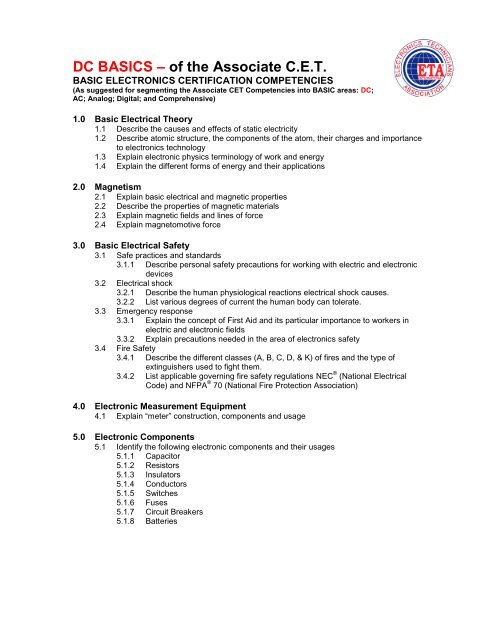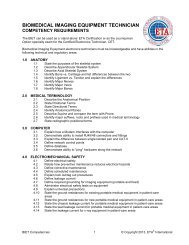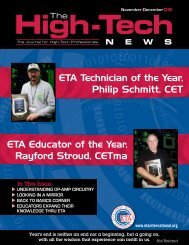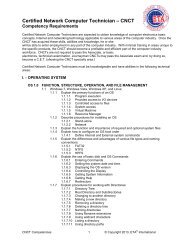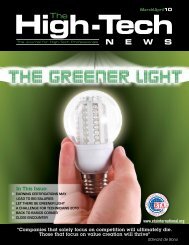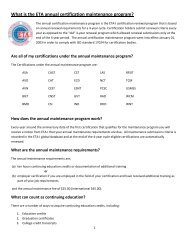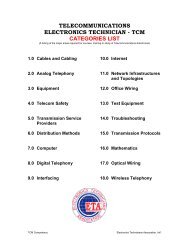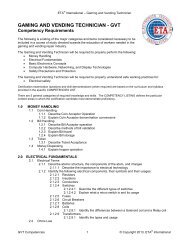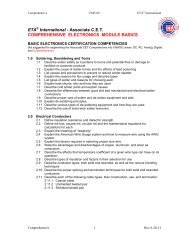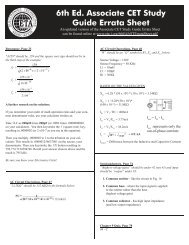EM1 - ETA International
EM1 - ETA International
EM1 - ETA International
You also want an ePaper? Increase the reach of your titles
YUMPU automatically turns print PDFs into web optimized ePapers that Google loves.
DC BASICS – of the Associate C.E.T.<br />
BASIC ELECTRONICS CERTIFICATION COMPETENCIES<br />
(As suggested for segmenting the Associate CET Competencies into BASIC areas: DC;<br />
AC; Analog; Digital; and Comprehensive)<br />
1.0 Basic Electrical Theory<br />
1.1 Describe the causes and effects of static electricity<br />
1.2 Describe atomic structure, the components of the atom, their charges and importance<br />
to electronics technology<br />
1.3 Explain electronic physics terminology of work and energy<br />
1.4 Explain the different forms of energy and their applications<br />
2.0 Magnetism<br />
2.1 Explain basic electrical and magnetic properties<br />
2.2 Describe the properties of magnetic materials<br />
2.3 Explain magnetic fields and lines of force<br />
2.4 Explain magnetomotive force<br />
3.0 Basic Electrical Safety<br />
3.1 Safe practices and standards<br />
3.1.1 Describe personal safety precautions for working with electric and electronic<br />
devices<br />
3.2 Electrical shock<br />
3.2.1 Describe the human physiological reactions electrical shock causes.<br />
3.2.2 List various degrees of current the human body can tolerate.<br />
3.3 Emergency response<br />
3.3.1 Explain the concept of First Aid and its particular importance to workers in<br />
electric and electronic fields<br />
3.3.2 Explain precautions needed in the area of electronics safety<br />
3.4 Fire Safety<br />
3.4.1 Describe the different classes (A, B, C, D, & K) of fires and the type of<br />
extinguishers used to fight them.<br />
3.4.2 List applicable governing fire safety regulations NEC ® (National Electrical<br />
Code) and NFPA ® 70 (National Fire Protection Association)<br />
4.0 Electronic Measurement Equipment<br />
4.1 Explain “meter” construction, components and usage<br />
5.0 Electronic Components<br />
5.1 Identify the following electronic components and their usages<br />
5.1.1 Capacitor<br />
5.1.2 Resistors<br />
5.1.3 Insulators<br />
5.1.4 Conductors<br />
5.1.5 Switches<br />
5.1.6 Fuses<br />
5.1.7 Circuit Breakers<br />
5.1.8 Batteries
Rev 08-25-12 Direct Current Basics <strong>ETA</strong> ® <strong>International</strong><br />
6.0 Ohms Law for Electronics<br />
6.1 Summarize Ohms law<br />
6.2 Calculate current, voltage or resistance using Ohms Law<br />
6.3 Define Joules and Kilowatt-hour as an energy unit<br />
6.4 Describe Watts Law<br />
6.5 Explain the characteristics of DC resistance<br />
7.0 Basic Mathematics for Electronics<br />
7.1 Describe the basic functions of a scientific calculator<br />
7.2 Explain basic algebraic math and its application in DC electronics<br />
7.3 Identify the scientific symbols used in DC electronics<br />
7.4 Convert fixed numbers to scientific notation<br />
7.5 Identify the fundamental and supplementary units that are the bases of the<br />
<strong>International</strong> System of Units (SI)<br />
7.6 Explain the following metric prefixes.<br />
7.6.1 Peta<br />
7.6.2 Tera<br />
7.6.3 Giga<br />
7.6.4 Mega<br />
7.6.5 kilo<br />
7.6.6 milli<br />
7.6.7 micro<br />
7.6.8 nano<br />
7.6.9 pico<br />
7.7 Demonstrate standard metric conversions.<br />
7.8 Explain algebraic equations relevant to DC circuitry.<br />
8.0 Electronic Measurements<br />
8.1 Describe the following electronic measurements and their application to DC<br />
electronics:<br />
8.1.1 Current<br />
8.1.2 Voltage<br />
8.1.3 Resistance<br />
8.1.4 Power<br />
9.0 Series Circuits for Electronics<br />
9.1 Explain how a series circuit is used in DC electronic equipment.<br />
9.2 Find total resistance in a series circuit<br />
9.3 Calculate an unknown current, voltage or resistance in a series circuit, using Ohms<br />
law.<br />
9.4 Describe Kirchhoff’s voltage law in a series circuit:<br />
10.0 Parallel Circuits for Electronics<br />
10.1 Explain how a parallel circuit is used in DC electronic equipment.<br />
10.2 Solve for total resistance of a parallel circuit<br />
10.3 Apply Kirchhoff’s current law in a parallel circuit<br />
10.4 Calculate current, in a parallel circuit, using the current-divider rule.<br />
<strong>EM1</strong> DC Basics 2 © Copyright 2012, <strong>ETA</strong> ® <strong>International</strong>
Rev 08-25-12 Direct Current Basics <strong>ETA</strong> ® <strong>International</strong><br />
11.0 Series/Parallel Combination Circuits for Electronics<br />
11.1 Describe the basic series/parallel combination circuit<br />
11.2 Calculate current, voltage, and resistance in a combination circuit<br />
11.3 Describe how Thevenin’s theorem is used to simplify an equivalent series/parallel<br />
circuit<br />
11.4 Solve for an unknown value in a combination circuit using Kirchoff’s law.<br />
11.5 Define Wheatstone bridge circuit and its usage<br />
11.6 Identify unknown voltages, currents, resistances and power dissipation in a loaded<br />
voltage divider circuit.<br />
12.0 Battery Power Supplies<br />
12.1 Describe battery construction<br />
12.2 Describe battery ratings<br />
End of DC BASICS Competencies Listing<br />
(with 12 major Categories)<br />
Notes:<br />
The purpose in distributing the above Competencies list is to provide a detailed syllabus for<br />
electronics educational institutions and instructors. Also to go further and explain what the student<br />
should be able to do with each of the items included in the Categories and Competencies listings.<br />
Find An <strong>ETA</strong> Test Site:<br />
http://www.eta-i.org/testing.html<br />
Suggested study texts:<br />
The Associate CET Study Guide, 6E; ISBN 1-891749-07-2; <strong>ETA</strong> <strong>International</strong>; 2012; —<br />
Available through <strong>ETA</strong> at 800-288-3824 or www.eta-i.org, $60<br />
Electronics; Principles and Applications,8E; ISBN 978-0077567705; Schuler; Career<br />
Education, 2002, pp. 594<br />
Introduction to Electricity, Electronics, and Electromagnetics, 5E; ISBN 978-0130105738;<br />
Boylestad, Nashelsky; Prentice Hall; 2001, pp. 666.<br />
Mastering Technical Mathematics, 3E; ISBN 978-0071494489; Gibilisco, Crowhurst; McGraw-<br />
Hill / TAB Electronics; 2007; pp. 627<br />
Electronics Principles, 7E; ISBN 978-0073222776; Malvino, Bates; McGraw-Hill Higher Career<br />
Education; 2007; pp. 1116<br />
Introductory DC/AC Electronics, 6E; ISBN 978-0131139848; Cook; Prentice Hall; 2004; pp.<br />
1024<br />
Electronic Communications, 6E; ISBN 978-0070571570; Shrader ; McGraw-Hill Co; 1990,<br />
pp. 864<br />
How to Test Almost Everything Electronic; ISBN 978-0830641277; Horn; McGraw-Hill/TAB<br />
Elec. 1993, pp. 326<br />
Basic Electronics Theory With Projects & Experiments, 4E; ISBN 978-0830642007; Horn;<br />
McGraw-Hill/TAB Elec. 1993, pp. 692<br />
Electricity; Principles and Applications,7E; ISBN 978-0073106991; Fowler; Glencoe/McGraw<br />
Hill, 2008<br />
The Soldering Handbook, 3E; ISBN 978-0871716187; Vianco; American Welding Society; 2000<br />
Introduction to Electronics; ISBN 978-0534012434; Crozier; Breton Pub.; 1983<br />
There Are No Electrons: Electronics for Earthlings; ISBN 978-0962781599; Amdahl;<br />
Clearwater Pub.; 1991<br />
Becoming An Electronics Technician, 4E; ISBN 978-0130932198; Reis; Prentice Hall; 2001<br />
<strong>EM1</strong> DC Basics 3 © Copyright 2012, <strong>ETA</strong> ® <strong>International</strong>


